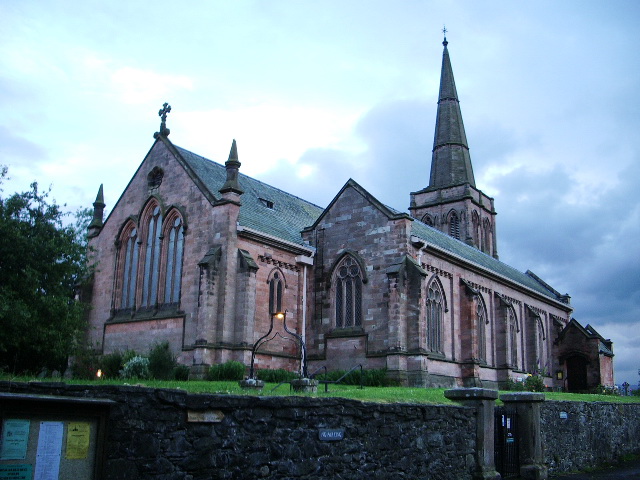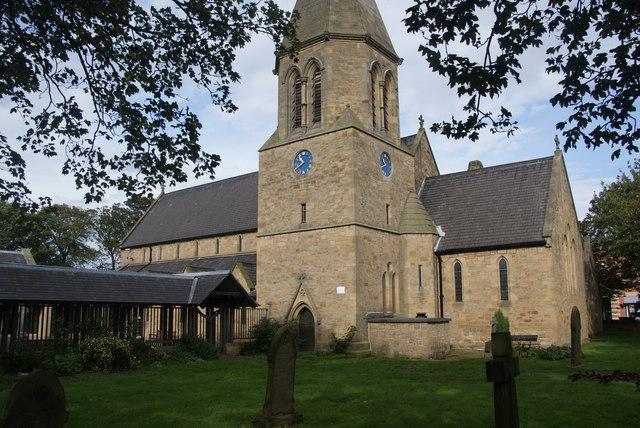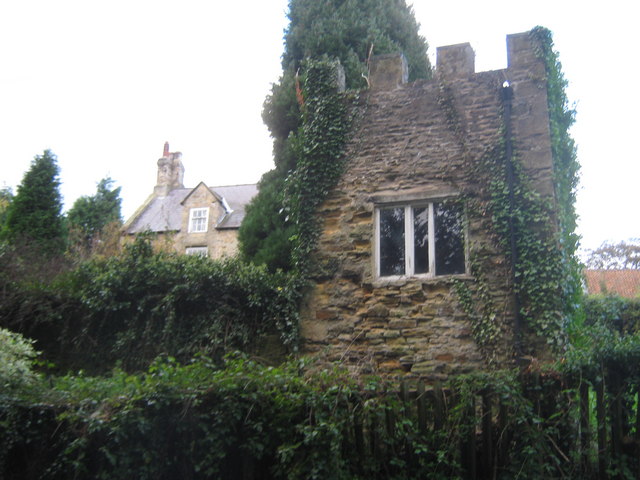Topics > People in History > Anthony Salvin (1799 -1881)
Anthony Salvin (1799 -1881)
Anthony Salvin (17 October 1799 – 17 December 1881) was an English architect. He gained a reputation as an expert on medieval buildings and applied this expertise to his new buildings and his restorations. He restored castles and country houses, and built a number of new houses and churches.
Early life and training
He was born in Sunderland Bridge, County Durham, as the only child of General Anthony Salvin, a soldier, and his second wife Elizabeth (Eliza) Mills. He was educated at Durham School and in 1820 became a pupil of John Paterson of Edinburgh while he was working on the restoration of Brancepeth Castle in County Durham.
In 1821 Salvin moved to London. He had an introduction to Sir John Soane but did not enter his office. According to his nephew he entered the office of John Nash. In 1824 he was elected as a fellow of the Society of Antiquaries. Soon after this he went on a sketching tour of Great Britain. On 26 July 1826 he married his cousin, Anne Andrews Nesfield. With her he had six children, two of whom died in infancy.
Early career
Salvin's first major commission was Mamhead Park in Devon for Robert William Newman. This was designed in the Tudor style to a symmetrical plan. It was adapted from a plan by Charles Fowler and this placed restrictions on his design. His next design was for Moreby Hall in the East Riding of Yorkshire for Henry Preston where he was free to develop a complete design in the Tudor style, again on a symmetrical plan. At Scotney Castle in Kent he designed for Edward Hussey an asymmetrical design in the Tudor style. In 1831 Salvin embarked on what is considered to be his most important early domestic work at Harlaxton Manor in Lincolnshire for Gregory Gregory. Salvin's design combined elements from Montacute House in Somerset and Hengrave Hall in Suffolk. However, before the building was complete, Salvin was replaced as architect by William Burn. In 1835 Salvin spent five weeks in Germany.
In 1836 Salvin entered a design in Tudor style in the competition for the new Palace of Westminster which had possibly been inspired by his visit to Germany. However this was unsuccessful, as was his entry for the competition to design the Ashmolean Museum in Oxford. He won the competition for the design of the Carlton Club in Pall Mall, London, but the club decided not to proceed with his plan. After losing a further competition, this time to design the Army and Navy Club, Salvin did not enter any more competitions.
Mature career
Most of Salvin's designs for major houses continued to be in the Tudor style. These include Keele Hall in Staffordshire for Ralph Sneyd, and Thoresby Hall in Nottinghamshire for Sydney Pierrepont, 3rd Earl Manvers. There were exceptions, including Penoyre House in Brecon, an Italianate villa-style house for Colonel John Lloyd Vaughan Watkins and Oxon Hoath in West Peckham, Kent in the French Châteauesque style for Sir William Geary.
A major part of Salvin's work was to restore, refit and create castles. In 1835 he refaced Norwich Castle, in 1844 he repaired the ruins of Newark Castle and in 1845 he repaired the ruins of Carisbrooke Castle on the Isle of Wight. In the early 1840s the Queen's Gate of Caernarvon Castle collapsed, and in 1844 Salvin repaired it and rebuilt some of the other masonry of the castle. He also restored Naworth Castle in Cumbria after it was damaged by a fire on 18May 1844. In 1851 he surveyed the Beauchamp Tower of the Tower of London and, after working on this he restored the Salt, the Wakefield and the White Towers and the Chapel of St Peter ad Vincula. Following this he was instructed by Prince Albert to carry out work on Windsor Castle. This included replacing sash windows with lancets and mullioned windows and rebuilding the Clewer Tower. Salvin designed Peckforton Castle in Cheshire for John Tollemache, 1st Baron Tollemache as a re-creation of a castle of the time of Edward I. In 1852 he started work on the restoration of Alnwick Castle in Northumberland. This included replacing one of the towers with a larger tower, the Prudhoe Tower, creating a porte-cochère, replacing windows and replanning the interior.
Salvin also restored and repaired 20 old churches and three cathedrals, and built 34 new churches. In the early 1840s he had worked on The Holy Sepulchre, Cambridge, employing James Rattee, and following this he was made an honorary member of the Cambridge Camden Society. He arranged for the removal of buildings around the south transept of Norwich Cathedral and reordered its choir. He also made alterations to Durham and Wells Cathedrals. In all he designed at least 34 new churches. Salvin's restorations were not to the liking of the Society for the Protection of Ancient Buildings, particularly his removal of "unwanted fabric" from churches. Other work carried out by Salvin included rebuilding the keep of Durham Castle for student accommodation, and work on restoring Trinity College, Cambridge.
Later life
In 1857, while working on Warwick Castle, Salvin suffered a stroke but recovered from it. In 1860, his wife died and he designed a new house for himself, Hawksfold at Fernhurst, Sussex. In 1863 he was awarded the royal gold medal of the Royal Institute of British Architects and in 1879 he retired from formal practice. He died at Hawksfold in 1881 and was buried at Fernhurst. His estate was valued at over £78,000.
Visit the page: Anthony Salvin for references and further details. You can contribute to this article on Wikipedia.

from https://commons.wikimedia.org…
Portrait of Anthony Salvin.
- Portrait of Anthony Salvin. Image Public domain by virtue of age.
Added by
Simon Cotterill

Co-Curate Page
Church of St John
- Overview Map Street View St John's Church in Keswick was built in 1838 by the eminent architect Anthony Salvin (1799-1881).The patron of the church was John Marshall, owner of a …

Co-Curate Page
Church of St Paul
- Overview Map Street View St Paul's Parish Church on Park View in Whitley Bay was built in 1864 by Salvin, and paid for by the Duke of Northumberland. The west …

Co-Curate Page
Brancepeth Castle
- Overview History Map The first castle in Brancepeth was a Norman castle built by the Bulmer family. It was rebuilt by the Neville family during the 14th century and it …

Co-Curate Page
Naworth Castle
- Overview About Naworth Castle Map Street View Naworth Castle, also known as, or recorded in historical documents as "Naward", is a castle in Cumbria, England, near the town of …

Co-Curate Page
Warkworth Castle
- Overview About Warkworth Castle Map Street View Warkworth Castle is a well preserved medieval castle which is cared for by English Heritage. The castle is located by a loop in …

Co-Curate Page
Alnwick Castle
- Overview History Map Street View Alnwick Castle is the seat of the Duke of Northumberland, built by the River Aln in Alnwick following the Norman conquest. The castle is open …

Co-Curate Page
Haughton Castle
- Overview About Haughton Castle Map Haughton Castle is a privately owned country house in Northumberland located a mile north of Humshaugh and on the south side of the River North …

Co-Curate Page
Askerton Castle
- Overview About Askerton Castle Map Street View Askerton Castle is a medieval fortified manor house in Cumbria, England. History Askerton Castle was built in the parish of Askerton in …

Co-Curate Page
Durham Castle
- Overview About Durham Castle Map Street View Durham Castle is a Norman castle in the city of Durham, England, which has been wholly occupied since 1840 by University College, …

Co-Curate Page
Grace Darling Memorial
- The memorial to Grace Darling (1815 - 1842) stands in the churchyard of St Aidan's Church in Bamburgh. The memorial was built in 1842, in a Gothic Revival style designed by …

Co-Curate Page
Durham Cathedral
- Overview History Map Inside The Cathedral Church of Christ, Blessed Mary the Virgin and St Cuthbert of Durham, usually known as Durham Cathedral and home of the Shrine of St …

Co-Curate Page
Church of St Mary the Virgin, Whickham
- Overview Map Street View St Mary the Virgin is the parish church in Whickham. The Norman church has a 12th century nave and 13th century aisles. The porch and tower …

Co-Curate Page
Rose Castle
- Overview About Rose Castle Map Street View Rose Castle is a fortified house, located about 6 miles south-west of Carlisle and just over 2 miles south of Dalston in Cumbria. …

Co-Curate Page
Church of St Michael and All Angels, Muncaster
- Overview About the Church Map Street View Inside The Church of St Michael and All Angels is the parish church of Muncaster. It is located in the grounds of Muncaster …

Co-Curate Page
Church of All Saints, Scotby
- Overview Map Street View All Saints Church in Scotby was built in 1854, designed by Athony Salvin and commissioned by George Head Head. It features an east window by William …

Co-Curate Page
Church of St Paul, Alnwick
- Overview Map Street View St Paul's RC Church on Percy Street in Alnwick was built in 1846 by Anthony Salvin. The church is a Grade II* listed building on the …

Co-Curate Page
Carlisle Station Hotel
- Overview Map Street View Carlisle Station Hotel is located on Court Square, Carlisle, a short distance from Carlisle Railway Station. The hotel was built in 1852 for George Head Head …

Co-Curate Page
Church of St John
- Overview Map Street View St John's is the parish church in Shildon. It was originally built 1833 - 1834 by Anthony Salvin. The church was largely rebuilt and extended in …

Co-Curate Page
Church of St. John the Evangelist, Percy Main
- Overview Map Street View St John's Church in Percy Main was built in 1862, by Anthony Salvin for the Duke of Northumberland. The church is Grade II listed on the …

Co-Curate Page
Hutton-in-the-Forest Grounds
- Overview Map Street View "A garden and kitchen garden with early C18 and earlier origins, the garden laid out under the guidance of Anthony Salvin in the later C19, and …

Co-Curate Page
Church of St James, Hutton-in-the-Forest
- Overview Map Street View St James' Church was built in 1714, incorporating part of the medieval church, with extensive restoration in 1867-1868 by Anthony Salvin, for the Fletcher-Vane family of …


from https://commons.wikimedia.org…
Portrait of Anthony Salvin.
- Portrait of Anthony Salvin. Image Public domain by virtue of age.
Added by
Simon Cotterill

Co-Curate Page
Church of St John
- Overview Map Street View St John's Church in Keswick was built in 1838 by the eminent architect Anthony Salvin (1799-1881).The patron of the church was John Marshall, owner of a …

Co-Curate Page
Church of St Paul
- Overview Map Street View St Paul's Parish Church on Park View in Whitley Bay was built in 1864 by Salvin, and paid for by the Duke of Northumberland. The west …

Co-Curate Page
Brancepeth Castle
- Overview History Map The first castle in Brancepeth was a Norman castle built by the Bulmer family. It was rebuilt by the Neville family during the 14th century and it …

Co-Curate Page
Naworth Castle
- Overview About Naworth Castle Map Street View Naworth Castle, also known as, or recorded in historical documents as "Naward", is a castle in Cumbria, England, near the town of …

Co-Curate Page
Warkworth Castle
- Overview About Warkworth Castle Map Street View Warkworth Castle is a well preserved medieval castle which is cared for by English Heritage. The castle is located by a loop in …

Co-Curate Page
Alnwick Castle
- Overview History Map Street View Alnwick Castle is the seat of the Duke of Northumberland, built by the River Aln in Alnwick following the Norman conquest. The castle is open …

Co-Curate Page
Haughton Castle
- Overview About Haughton Castle Map Haughton Castle is a privately owned country house in Northumberland located a mile north of Humshaugh and on the south side of the River North …

Co-Curate Page
Askerton Castle
- Overview About Askerton Castle Map Street View Askerton Castle is a medieval fortified manor house in Cumbria, England. History Askerton Castle was built in the parish of Askerton in …

Co-Curate Page
Durham Castle
- Overview About Durham Castle Map Street View Durham Castle is a Norman castle in the city of Durham, England, which has been wholly occupied since 1840 by University College, …

Co-Curate Page
Grace Darling Memorial
- The memorial to Grace Darling (1815 - 1842) stands in the churchyard of St Aidan's Church in Bamburgh. The memorial was built in 1842, in a Gothic Revival style designed by …

Co-Curate Page
Durham Cathedral
- Overview History Map Inside The Cathedral Church of Christ, Blessed Mary the Virgin and St Cuthbert of Durham, usually known as Durham Cathedral and home of the Shrine of St …

Co-Curate Page
Church of St Mary the Virgin, Whickham
- Overview Map Street View St Mary the Virgin is the parish church in Whickham. The Norman church has a 12th century nave and 13th century aisles. The porch and tower …

Co-Curate Page
Rose Castle
- Overview About Rose Castle Map Street View Rose Castle is a fortified house, located about 6 miles south-west of Carlisle and just over 2 miles south of Dalston in Cumbria. …

Co-Curate Page
Church of St Michael and All Angels, Muncaster
- Overview About the Church Map Street View Inside The Church of St Michael and All Angels is the parish church of Muncaster. It is located in the grounds of Muncaster …

Co-Curate Page
Church of All Saints, Scotby
- Overview Map Street View All Saints Church in Scotby was built in 1854, designed by Athony Salvin and commissioned by George Head Head. It features an east window by William …

Co-Curate Page
Church of St Paul, Alnwick
- Overview Map Street View St Paul's RC Church on Percy Street in Alnwick was built in 1846 by Anthony Salvin. The church is a Grade II* listed building on the …

Co-Curate Page
Carlisle Station Hotel
- Overview Map Street View Carlisle Station Hotel is located on Court Square, Carlisle, a short distance from Carlisle Railway Station. The hotel was built in 1852 for George Head Head …

Co-Curate Page
Church of St John
- Overview Map Street View St John's is the parish church in Shildon. It was originally built 1833 - 1834 by Anthony Salvin. The church was largely rebuilt and extended in …

Co-Curate Page
Church of St. John the Evangelist, Percy Main
- Overview Map Street View St John's Church in Percy Main was built in 1862, by Anthony Salvin for the Duke of Northumberland. The church is Grade II listed on the …

Co-Curate Page
Hutton-in-the-Forest Grounds
- Overview Map Street View "A garden and kitchen garden with early C18 and earlier origins, the garden laid out under the guidance of Anthony Salvin in the later C19, and …

Co-Curate Page
Church of St James, Hutton-in-the-Forest
- Overview Map Street View St James' Church was built in 1714, incorporating part of the medieval church, with extensive restoration in 1867-1868 by Anthony Salvin, for the Fletcher-Vane family of …

Church of St. Mungo, Simonburn

Church of St Patrick, Patterdale

Church of St Michael and All Angels, Muncaster

Church of St Paul, Whitley Bay

Church of St James, Hutton-in-the-Forest

Church of St. John the Evangelist, Percy Main

Sunderland Bridge, County Durham

Church of St Paul, North Sunderland

Carlisle Station Hotel, Court Square, Carlisle










